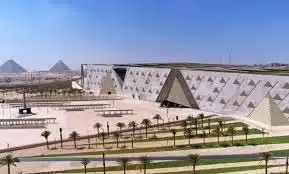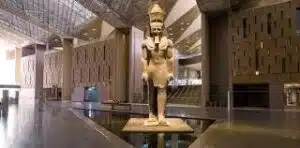The Grand Egyptian Museum in 2025
The Grand Egyptian Museum (GEM), scheduled to open in 2025, represents one of Egypt’s most ambitious cultural projects. Strategically located near the Pyramids of Giza, the museum aims to preserve, present, and interpret Egypt’s rich historical heritage through advanced technological systems, modern infrastructure, comprehensive research facilities, and international partnerships. This paper provides an academic overview of the GEM’s history, purpose, architectural design, exhibitions, educational role, sustainability measures, and future prospects.
1. Introduction
The Grand Egyptian Museum (GEM) stands as a monumental cultural initiative designed to showcase Egypt’s extensive archaeological heritage to the world. Positioned adjacent to the Pyramids of Giza, the museum benefits from a historically symbolic and strategically accessible location. Occupying more than 480,000 square meters, the GEM is envisioned as the world’s largest archaeological museum, displaying over 100,000 artifacts, including significant Pharaonic collections.
In addition to serving as a major tourist attraction, the museum is intended to fulfill educational and research-oriented roles through workshops, seminars, and academic programs. By blending modern architectural aesthetics with ancient Egyptian heritage, the GEM is expected to enhance cultural tourism and support Egypt’s economic development.

2. Historical Background
The concept behind the Grand Egyptian Museum originated in 2002 with the ambition to establish a modern institution capable of preserving and presenting significant cultural artifacts. Despite numerous challenges—including funding limitations, complex engineering requirements, and the environmental sensitivity surrounding ancient relics—the museum’s development progressed through coordinated efforts between local authorities and international specialists.
Major structural components were completed by 2020, reflecting Egypt’s commitment to realizing a culturally significant project of global stature. Among the museum’s central attractions is the unparalleled collection of artifacts belonging to King Tutankhamun.
3. Exhibitions and Collections
The GEM’s exhibitions are designed to offer a comprehensive overview of Egyptian history across multiple eras, from prehistoric periods to the Pharaonic, Greek, and Roman epochs. Many of the artifacts—including mummies, statues, and rare antiquities—are being displayed to the public for the first time.
A central highlight is the complete collection from the tomb of Tutankhamun, providing visitors with an immersive encounter with ancient Egyptian culture, craftsmanship, and spirituality. The exhibition strategy incorporates cutting-edge display technologies to enhance narrative storytelling and encourage deeper engagement with the artifacts.
4. Architectural Design and Modern Infrastructure
The architectural philosophy of the GEM emphasizes the integration of modern design with Egypt’s cultural identity. The museum’s proximity to the Pyramids enriches its visual and historical context while offering visitors an unparalleled cultural experience.
The facility includes:
-
Dedicated accessibility features
-
Information centers
-
Rest areas, cafés, and restaurants offering local and international cuisine
-
Advanced technological systems such as interactive screens and 3D projectors
These features aim to ensure comfort, accessibility, and enriched learning for all visitors.

5. Visitor Experience and Interactive Technologies
Recognizing the rapid evolution of digital technologies, the GEM is incorporating augmented reality (AR), virtual reality (VR), and interactive educational tools to create an immersive visitor environment. Educational programs target children, youth, and adults through workshops, guided tours, and hands-on learning activities.
Mobile applications will facilitate digital navigation, allowing visitors to customize their museum experience and access interpretive content. This integration of technology not only enhances individual engagement but also fosters a collaborative virtual community among visitors.
6. Educational and Research Role
The GEM serves as an academic hub offering substantial resources for students, researchers, and scholars in the fields of archaeology, museum studies, and ancient history. Through its extensive collections and educational initiatives, the museum functions as a primary source for academic inquiry.
The museum hosts:
-
Workshops
-
Scientific lectures
-
Academic conferences
-
Research collaborations with universities and global institutions
These initiatives contribute to the development of innovative methodologies in archaeological research and historical analysis.
7. International and Local Partnerships
The GEM collaborates with international museums and cultural institutions to foster knowledge exchange, coordinate traveling exhibitions, and strengthen Egypt’s cultural presence on the global stage. Locally, the museum partners with educational institutions to promote cultural literacy, national identity, and public engagement with Egypt’s heritage.
These partnerships are essential for enhancing the museum’s cultural influence and ensuring its long-term success as a global cultural hub.
8. Environmental Sustainability
Environmental sustainability is a core principle of the museum’s design. Key sustainable features include:
-
Solar energy systems to reduce reliance on fossil fuels
-
Advanced thermal insulation to minimize energy consumption
-
Green spaces to improve environmental health
-
Water management systems, such as rainwater harvesting and reuse
The museum thus exemplifies eco-conscious architectural practices that align with Egypt’s broader sustainability goals.

9. Future Prospects
Following its anticipated opening in 2025, the GEM is expected to significantly boost cultural tourism in Egypt. The increase in visitor numbers is projected to stimulate the local economy, generate employment opportunities, and enhance community development.
Educational programs, temporary exhibitions, and international cultural events will further position the GEM as a dynamic, influential institution within the global museum landscape. The museum’s emphasis on cultural education will support national identity formation among younger generations while strengthening Egypt’s global cultural profile.
Conclusion
The Grand Egyptian Museum represents a landmark achievement in Egypt’s cultural, educational, and architectural landscape. By combining archaeological preservation with modern technologies and sustainability practices, the museum stands as a global model for cultural institutions of the future. Its opening in 2025 is anticipated to contribute significantly to Egypt’s tourism sector, academic community, and cultural heritage preservation efforts.








No comment